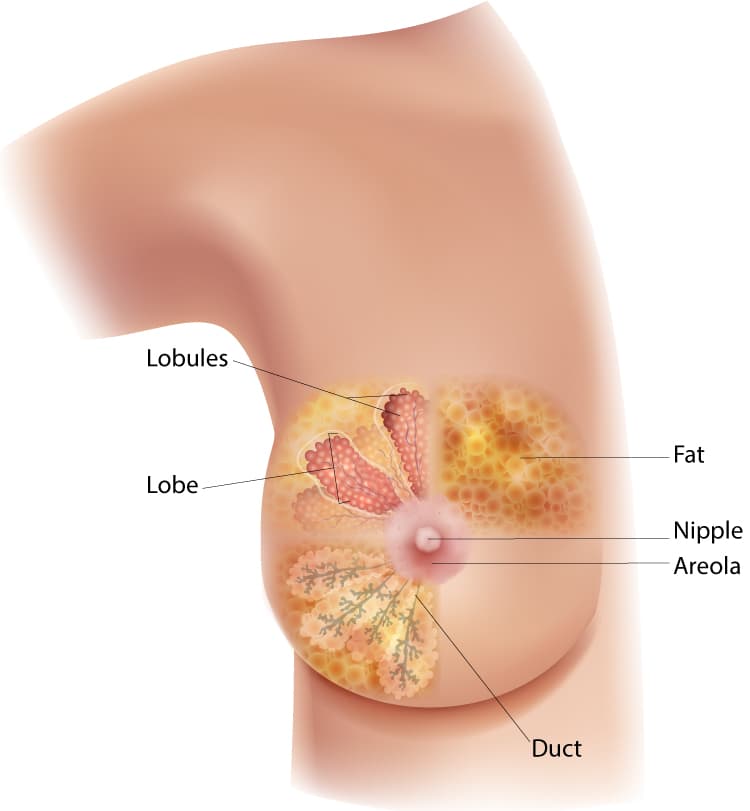By Iptisam Abdallah, Kakamega
Breast cancer is a disease in which cells in the breast grow out of control.Breast cancer is one of the top three leading cancers that claim lives of women in Kenya accounting to 9.6 per cent of the population.
Studies find that it affects both genders but is most common in women. It is a disease which affects the breasts and occurs when breast cells grow abnormally, divide more rapidly than healthy cells and accumulate forming a lump.
A breast is made up of three main parts: lobules which are glands that produce milk, ducts that are tubes that transports milk to the nipple and connective tissue consisting of fibrous and fatty tissue that surrounds and holds all parts of the breast in place. Breast cancer can begin from any of these parts.

According to the latest report by the National Cancer Institute (NCI-K) under the chairmanship of Dr Githinji Gitahi, Nairobi, Kiambu, Nyeri, Kakamega, Murang’a, Kitui, Kirinyaga and Embu are the leading counties with the number of cancers reported cases.
The counties Wajir, Lamu, Tana River and Elgeyo Marakwet had no cancer case reported during the study period.
Causes
According to the study, the leading causes of breast cancer were identified as hormonal, lifestyle and environmental factors.
Doctors have estimated that about 5 to 10 per cent of breast cancers are linked to gene mutations passed through generations of a family. Inherited mutated genes which include breast cancer gene 1(BRCA1) and breast cancer gene 2(BRCA 2) are identified to significally increase the risk of breast cancer.
Risk factors
Factors that increase the chances of someone developing breast cancer include increasing age, being female, a personal history of breast cancer, radiation exposure , obesity, beginning of menses at a younger age, beginning menopause at an old age, drinking alcohol, having your first child at an older age and undergoing postmenopausal therapy.
Types
A type of breast cancer can be determined by specific cells that become cancer. Breast cancer is divided into 2 main categories, the invasive and the non invasive.
Invasive breast cancer
Invasive breast cancer is the type that has spread from its original site to other areas like nearby breast tissue and lymph nodes. Invasive breast cancers are divided into,
Invasive ductal carcinoma
This is the most common type and starts from the milk duct spreading throughout other parts of the breasts
Invasive lobular carcinoma
This is the second most common type of cancer that starts from lobules spreading to other breast tissues. It is harder to detect compared to invasive ductal carcinoma.
Inflammatory breast cancer
This type of cancer may be detected from ducts and lobules and spreads faster being aggressive. It got its name from inflammatory signs it causes such as redness and swelling on the surface of the breast and is often misdiagnosed as breast infection.
Paget’s disease of the breast
This is a much less common type of breast cancer which occurs in people who have other type of cancers. It develops in the skin of the nipple and areola creating unique tumor cells called Paget cells.
Angiosarcoma of the breast
This is a rare type of cancer that forms in the lining of lymph and blood vessels and is common to people older than 70. It is frequently caused by complications from radiation therapy.

Phyllodes tumors
This cancer is found in the connective tissue of the breast. It mostly affects women in their 40’s.
Non –invasive breast cancer
This type of cancer cells are non-invasive and remain in a particular location of the breast without spreading to surrounding tissues. Non-invasive cancers include
Ductal carcinoma in situ (DCIS)
It is a type of cancer that starts as a mass growing in a milk duct, break through the ductal walls overtime into the surrounding tissue and fast of the breast.
Lobular carcinoma in situ ( LCIS)
This involves a change in the breast caused by cells resembling cancer cells growing rapidly inside lobules and hence increase the risk of breast cancer.
Symptoms
Symptoms of breast cancer vary in different patients according to the degree of spread of cancerous cells and the stages of its spread.
Common symptoms include nipple discharge other than breast milk including blood, any change in the size and shape of the breast, pain in any area of the breast, irritation or dimpling of breast skin, pulling in of the nipple, pain in the nipple area, new underarm lump or breast area, thickening or swelling of part of the breast and redness and flaky skin in the nipple and breast area.
Although this symptom is associated with breast cancer, they may not actually validate that you are suffering from it until medical diagnosis is done. These symptoms can occur in other medical conditions that are not cancer.
More so, women’s’ breasts come in different sizes and shapes and can change due to factors such as breastfeeding, having children, losing or gaining weight, aging, or taking certain types of medication that alters normal functions of the body.
Stages
Stages of breast cancer determine how extensive it is, including the size of tumor, its degree of spread to the lymph nodes and different parts of the body and what its biomarkers are. The process of identifying the stages of breast cancer by medical experts is known as staging and can be done before or after surgery.

Staging is done by doctors who use diagnostic tests so as to be able to recommend the ideal treatment for the cancer.
The stages of breast cancer include stage 0, stage IA, stage IB, stage IIA, Stage IIB, stage III A, stage III B, Stage III C, stage IV and recurrent stage.
Stage 0, also called non-invasive or situ cancer, describes that disease has spread only in the ducts of the breast and not in the surrounding breast tissues.
Stage IA is the phase where the tumor is small, invasive and has not spread in the lymph nodes. Stage IB occurs when cancer spread to the lymph nodes is larger than 0.2 mm but less than 20 mm in size, a smaller tumor of about 20 mm or no sign of it at all in the breast.
Stage II A is characterized by either of the following; a tumor that is 20 mm smaller an has spread to 3 axillary lymph nodes, a tumor that is larger than 20mm smaller than 50mm and has not spread in the lymph nodes or no evidence of a tumor in the breast but the cancer has spread to1-3 axillary lymph nodes.
Stage II B is characterized by either presence of a tumor larger than 20 mm, smaller than 50 mm and has spread to 1-3 axillary lymph nodes or a tumor larger than 50mm but has not spread to the axillary lymph nodes.
Stage III A is characterized by a tumor of any size that has spread to 4-9 axillary lymph nodes of to internal mammary lymph nodes.
Stage III B is characterized by the spread of tumors to the chest wall causing swelling or alceration of the breast.
Stage III C is characterized by a tumor of any size that has spread to 10 or more axillary lymph nodes, internal mammary lymph nodes and lymph nodes under the collarbone.
Stage IV (metastatic) is characterized by a tumor of any size that has spread to other organs such as lungs, bones, brain, liver, distant lymph nodes or chest walls. This is most common after a previous diagnosis of early breast cancer.
Recurrent cancer
This is cancer that has come back after treatment and can be described as local, regional or distant.
Prevention
Prevention of breast cancer is a better option than treating it. Prevention measures involve healthy habits such as limiting alcohol intake, breastfeeding, limiting postmenopausal hormone therapy, eating a healthy diet, exercising to avoid obesity, discussing contraceptive options with doctors and seeking immediate medical attention upon noticing any changes in your breasts.
Treatment
Breast cancer treatments are offered by medical oncologists, radiation oncologists and surgeons Breast cancer treatments vary according to the extent of spread and the stage of the disease in a patient.
The treatment include surgery that involves operations to cut out cancer tissue, chemotherapy that involves the use of special medicines to kill cancer cells, hormonal therapy that blocks cancer cells from getting hormones that trigger growth, biological therapy that helps the immune system fight cancer cells and radiation therapy that involves subjecting cancer cells to high energy rays that kills them.
Ends




